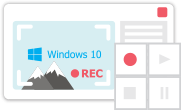Video Editor
Use free video software to create and edit videos of any complexity from a family greeting card to a company presentation. Cut, merge video files, apply visual and audio effects, use filtration and image correction, make slideshows and add an appropriate soundtrack. Use multi-color Chroma Key and advanced parameters settings to give your video a professional look. All popular video and audio formats are supported.
Video Converter
This program is intended for converting video files from one format to another. Nearly all popular video formats are supported (both reading and saving). In addition, the program drastically simplifies the task of converting videos for playback on specific multimedia devices, such as iPhone, Samsung Galaxy or Huawei P30 Pro. The program is extremely easy to use, has a modern interface and all necessary video processing functions.
Audio Converter
The audio converter will help you convert audio files from one format to another. All key audio formats and codecs are supported. The program also allows you to manage playlists and meta tags, extract audio from video files and save these tracks on your computer in any format.
Audio CD Grabber
This audio tool is intended for grabbing audio tracks from compact discs and saving them to the user’s computer in any format. Nearly all popular audio formats and codecs are supported. The program can also extract track details from the FreeDB server for automatic file renaming and updating meta tags.
Video Editor
Video Converter
Audio Converter
Audio CD Grabber

Multifunctionality
A wide array of multimedia processing tools in one free video software suite.

High speed
Our programs use fast
and high-quality algorithms optimized for single and multi-core CPU’s.

Affordability
VSDC video software is freely available for download to Windows OS-based PCs and laptops.
- This holiday season embraces new beginnings with the latest update of VSDC Video...
- Change is all about improvement, and this process wouldn't be possible without y...
- Intro In 2024 the options range for creating visual effects is incredibly dive...
- Are you ready to explore new heights with the latest major VSDC update? Finally,...
FREE Video editor Rolls Out New Transitions and Animated Text Effects
Of all effects, there are two categories the VSDC community gets especially excited about: transition effects and text effects. It happens so that the new version brings updates to both categories. In addition, there are new workspace customization possibilities, including optimized file management and the long-awaited markers.
The best part? Most updates are available in the free version. Let’s review them one by one.
Paper burn effect (Pro version)
The paper burn transition effect creates a realistic illusion of a burning piece of paper that reveals the following scene. You can apply it to videos, however, it looks even more impressive when applied to a still image.
Like all effects in VSDC, the paper burn transition is fully customizable. You can adjust the color, size, direction, and intensity of the flame. As an alternative template for this transition, you can select freezing.
The cherry on top? If you activate time inversion for this transition, the effect gets reversed. For instance, instead of a burning piece of paper, you’ll get a piece of paper that is restored from being burnt.
Flow transformation effect (Pro version)
Those who frequently use the Glitch effect, are likely to be excited about the new transition effect called Flow transformation. With this option, the transition from one scene to another is achieved through a fractal-driven image distortion that varies depending on the template you select.
For example, you can create an effect of an object not just being distorted, but falling into a thousand pieces. With the time inversion, you can imitate the opposite process as well: when an object is being put back together from a thousand pieces.
The effect contains 4 main template types with variations. Those who like to experiment will be able to upload their own distortion patterns, customize the distortion, and create a custom transition.
Animated text effects
Finally, VSDC 6.7 includes three animated text effects: Recoloring, Shift position, and Glyph FX. Designed to help you get full control of how text symbols appear in the scene, they enable you to create Hollywood-level intros, scene openings, and captions.
The Recoloring effect allows for changing the color or the level of opacity of text symbols. For instance, by making the letters on the screen appear one after another (switch from being transparent to being non-transparent), you can easily create the popular Typewriter effect, or its inverted “Undo typing” version.
The Shift position effect allows for making text symbols move from one location to another on the screen. The Glyph FX effect allows for changing the appearance attributes of text symbols, such as their size, skew angle, or rotation.
You can apply these effects separately or combine them in a single composition. For example, if you want text symbols to change their color and location at the same time, you can apply Recoloring and Shift position to the same text object.
VSDC Editor brings a more convenient workspace for creators
In addition to the new effects, the new version of VSDC includes markers and a few additional ways to organize your editing workspace. For example, there are 3 new workspace configurations designed for those who deal with a large number of project files, those who focus on color correction, and those who already enjoy the default editing space but want it to be a bit more organized.
And that’s not all! The Object explorer now includes a search field, so you can quickly find files or groups of files in the project. The Resource window has been redesigned as well. Starting the new version, it enables you to select multiple files simultaneously, export files in groups, and delete those files you’re not using.
Remember to download VSDC 8.2 from our official website, and feel free to email us at This email address is being protected from spambots. You need JavaScript enabled to view it. if you have any questions.
More Articles...

This program allows you to capture the video of your desktop and save it on your PC in various formats. Coupled with a video editor, the program is a great tool for creating presentations, tutorials and demo videos.

The program captures video from external devices and records it to computer in a free format. You can save video from video tuners, webcams, capture cards and other gadgets.

"VSDC Free Video Editor is a surprisingly powerful, if unconventional video editor"
- PC Advisor

"This video editor gives you tons of control and editing power"
- CNet

"The editor handles many common formats and boasts a good deal of capabilities when it comes time to alter lighting, splice video, and apply filters and transitions in post production"
- Digital Trends




















